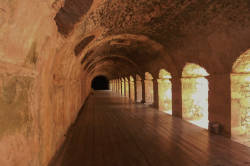Cryptoporticus
Cryptoportico
CRYPTO-PORTICUS (Gr. κρυπτός, concealed, and Lat. porticus), an architectural term for a concealed or covered passage, generally underground, though lighted and ventilated from the open air.
One of the best-known examples is the crypto-porticus under the palaces of the Caesars in Rome.
In Hadrian’s villa in Rome they formed the principal private intercommunication between the several buildings.
Hugh Chisholm ed. (1911): Encyclopædia Britannica, Vol. 7 (11th ed.). Cambridge University Press. p. 566.


A cryptoporticus (cryptoportico) is a semi-subterranean gallery whose vaulting supports portico structures aboveground. In other words it was intended as a basement for another structure and was actually never seen as a building. It’s just a technology to make a horizontal ground on which other buildings could be erected on a sloping site. The Latin word cryptoporticus comes from crypta and porticus, a semi-subterranean gallery whose vaulting supports portico structures above ground. While cryptoportico were useful for the forum, they were also used as basements for Roman villas, and then called basis villae.
In other words it was a sort of shared basement for any number of buildings surrounding the forum. The forum was the central marketplace of any Roman city. An open space was surrounded on three sides by buildings, which were religious buildings for the various cults and other infrastructure. So the basement typically consisted of three straight tunnels forming a U. They had no huge machines to move great amounts of rocks, so they actually built walls and covered them by Roman vaults aka barrel vaults. Such a passage needs much fewer rocks, and is stable enough.
As the site is sloping the floor inside the tunnels, which is generally the original surface, is also sloping, So the different tunnels have different height, the goal was that the top of all three tunnels had the same level. There was no need for a certain height as the inside was not used, it was just a foundation. Some tunnels had windows in the upper part for light, there was a hidden staircase into the structure, most likely for maintenance or security. However, during Roman times it was not used for any purpose, it was closed to the public.
Several cryptoporticos were used during the Middle Ages as cellars, warehouses, or cave houses. Some were filled in during the construction of later buildings. Some remained almost unchanged, as the forum was an open space which was rather useful, it often stayed as a marketplace and later probably a public park during the times.
- Examples
 Arles Cryptoportiques du Forum
Arles Cryptoportiques du Forum Criptoportico Forense
Criptoportico Forense Neronian Cryptoporticus
Neronian Cryptoporticus Reims Cryptoportique
Reims Cryptoportique
 Search DuckDuckGo for "Cryptoporticus"
Search DuckDuckGo for "Cryptoporticus" Cryptoporticus - Wikipedia (visited: 21-APR-2022)
Cryptoporticus - Wikipedia (visited: 21-APR-2022)
 Index
Index Topics
Topics Hierarchical
Hierarchical Countries
Countries Maps
Maps